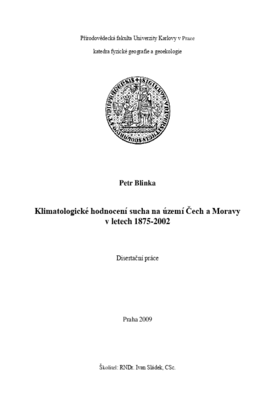Klimatologické hodnocení sucha na území Čech a Moravy v letech 1875-2002
Climatological evaluation of drought on the territory of Bohemia and Moravia in the years 1875-2002
dissertation thesis (DEFENDED)

View/
Permanent link
http://hdl.handle.net/20.500.11956/2587Identifiers
Study Information System: 77102
CU Caralogue: 990011213810106986
Collections
- Kvalifikační práce [21469]
Author
Advisor
Referee
Klabzuba, Jiří
Munzar, Jan
Faculty / Institute
Faculty of Science
Discipline
Physical Geography
Department
Department of Physical Geography and Geoecology
Date of defense
21. 9. 2009
Publisher
Univerzita Karlova, Přírodovědecká fakultaLanguage
Czech
Grade
Pass
Disertační práce vznikla s podporou grantového projektu "Dlouhodobé změny režimu výskytu extrémního sucha v Česku". Analýza sucha na území Česka v letech 1875-2002 vycházela z osmi vybraných stanic s nejdelšími denními řadami teplot a srážek, které reprezentují klima středních a nižších poloh. Práce sleduje dva hlavní cíle: hodnocení intenzity sucha v předem zvolených kalendářních jednotkách (roky, vegetační období - měsíce duben až září) a vymezení nejvýraznějších period sucha. Vedle dvou zcela nových objektivních indexů DI a EvaDI byla intenzita sucha na jednotlivých stanicích kvantifikována také na základě charakteristiky EDI, jež vychází z metody efektivní srážky autorské dvojice H. R. Buyn a D. A. Wilhite. Zvláštní pozornost věnujeme stanici Praha-Klementinum, pro kterou jsme spočítali odhady denních úhrnů potenciální evapotranspirace. Ty jsou společně s denními úhrny srážek základem dalších tří nově zkonstruovaných indexů intenzity sucha EDImod, EDI2 a EvaDI2. Metodu efektivní srážky jsme využili také při vymezování nejvýraznějších period sucha. Jejich průnikem na všech stanicích dostáváme časové úseky, ve kterých sucho zasáhlo celé území Česka. Na stanici Praha-Klementinum jsme vyzkoušeli také námi navrženou modifikaci metody efektivní srážky, která spočívá v začlenění odhadů denních úhrnů...
The thesis arose with the support of the project "Long-term changes in the regime of occurrence of extreme drought in Czechia". The drought evaluation was based on 8 weather stations which were chosen according to the length of their measurement. They represent the climate of lower and central positions. Two main aims are followed: quantification of drought severity in calendar units (years, vegetation seasons - months April till September) and determining of most considerable dry spells. Beside two new indices DI and EvaDI the drought severity was also quantified by EDI which is based on the concept of the effective precipitation method proposed by H. R. Buyn a D. A. Wilhite. We paid special attention to the weather station Prague-Klementinum for which we estimated values of daily potential evapotranspiration. We used these estimates together with daily precipitation values for calculation of three other new drought indices EDImod, EDI2 and EvaDI2. We determined the most considerable dry spells by using the effective precipitation method. We also tried to identify dry spells which occurred at the same time at all weather stations. At the weather station Prague-Klementinum we tested out the modified effective precipitation method. Beside daily precipitation our modification also counts with values...
